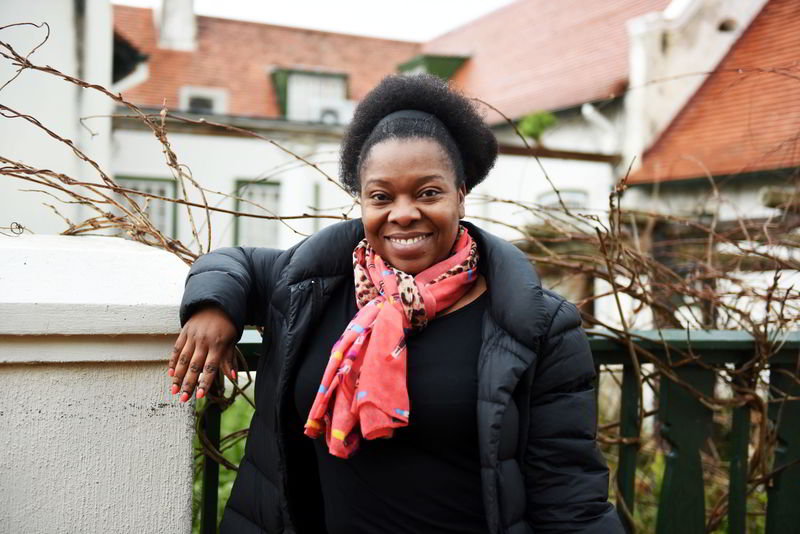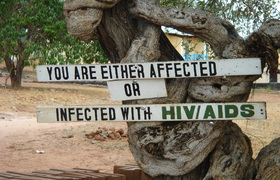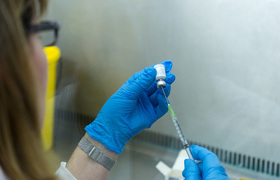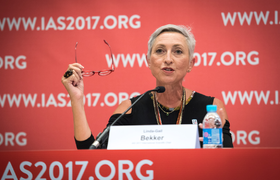From adolescence to adulthood with HIV
17 August 2018 | Story Helen Swingler. Photo Robyn Walker. Read time 6 min.
Social behavioural scientist Dr Millicent Atujuna’s Collaborative Initiative for Paediatric HIV Education and Research (CIPHER) award underpins her study on how adolescents living with HIV transition into adulthood – the questions they ask, how they cope with extreme poverty, and how to retain them in care.
Her study is titled “The impact of poverty on anti-retroviral therapy of South Africa’s generation of adolescents living with HIV: Implications for strategies and intervention development”.
Atujuna heads the socio-behavioural division of the Desmond Tutu HIV Foundation (DTHF), based in the University of Cape Town’s (UCT) Institute of Infectious Disease and Molecular Medicine. She is one of two UCT researchers who received these prized awards, which offer up to US$150 000 over two years to support studies on paediatric and adolescent HIV. Dr Elona Toska, of the AIDS and Society Research Unit, is the other recipient.
Social behaviourists play a vital role in the understanding of HIV/AIDS and society. An important facet of HIV research is understanding the complex drivers of human behaviour that underlie successful HIV prevention and treatment, says Atujuna.
“So, it is this bridge that connects the community, the society, the end-users of treatment and the clinical world that is developing new medical interventions.”
Her two-year study will generate baseline data on how adolescents living with HIV cope with the transition to adulthood, and how extreme poverty affects their retention in care and prevention programmes. The goal is also to provide direction for future structural interventions and policy change.
Ugandan experience
Atujuna came to South Africa in 1999 after completing her first degree at Makerere University in Uganda. Her experience of the AIDs pandemic in that country provided valuable insights into how communities coped, and how those living with HIV were cared for.
With an initial high number of AIDS-related deaths in Uganda, she became sensitised to the risks of HIV/AIDS as a young girl.
"Back then people thought you got HIV from toilet seats.”
“There were no ARVs, lots of people were dying and the questions was: What can we do and how can we protect ourselves? Back then people thought you got HIV from toilet seats.”
Uganda’s successful prevention campaign was driven by political will and by enlisting individuals living with HIV who had high social capital.
“Essentially, they became the posters boys and girls for the education campaign,” Atujuna said.
When she came to South Africa, her master’s thesis was a comparison study of HIV in South Africa and Uganda.
“One of my themes was lived experience. The comparison obviously suggested that Uganda had more experience and that that impacted their behaviour, which South Africa didn’t have at that time.”
Psychosocial education
Her interest in the field led to a PhD on AIDS and religion and its influence on HIV prevention. She did her research in Mtubatuba, north of Richards Bay. She joined UCT in 2009 and the DTHF in 2014.
But even before then, Atujuna had started asking questions. How were children living with HIV, who were perinatally infected, transitioning into adulthood? What sorts of questions were they asking themselves? What about having children of their own? Were they already thinking about that? Were they thinking about having sex? If they were having sex, how could we ensure that they were safe?
She enlisted with the DTHF’s Hannan-Crusaid Treatment Centre in Gugulethu for a six-month session-based, psychosocial education youth programme.
“One of the things I noticed was the poverty the youth were living in and how that affected their general well-being. I also noticed how they were nonetheless adhering to treatment and how they were being retained in care at the centre,” she said.
“I wanted to explore, to figure out: Are there any interventions we [can] adopt to generate evidence to help adolescents who are HIV-positive, who are on treatment, to be retained in care and to adhere to the ARV treatment?”
“What sorts of questions were they asking themselves? What about having children of their own? Were they already thinking about that? Were they thinking about having sex?”
The poverty factor
The study will deepen our understanding of what the concept of poverty means for adolescents around the country who are living with HIV.
“How do we develop interventions that target adolescent poverty? Is their non-adherent behaviour or failure to be retained in care linked to this poverty? I want to disaggregate what proportion of non-adherent behaviour and non-retention in care is actually explained by poverty.”
Once Atujuna has defined the basic concepts and tools that can be used to define poverty, she will conduct qualitative interviews with these children and their parents.
“More importantly, if we were to introduce interventions, what would they look like, what would work for these adolescents? We need to find interventions that build people, interventions they can implement themselves.”
Atujuna has a huge heart for these young people. Adolescents are trying so hard to comprehend this cycle of life, she said.
“It’s so encouraging to see how they’ve thrived, given what they have endured over time.
“I like their resilience. I like it that they’re still surviving; that they’re still trying to take drugs [ARVs]. But they need more help, more assistance to have the self-confidence and to simply be adolescents.”
 This work is licensed under a Creative Commons Attribution-NoDerivatives 4.0 International License.
This work is licensed under a Creative Commons Attribution-NoDerivatives 4.0 International License.
Please view the republishing articles page for more information.










